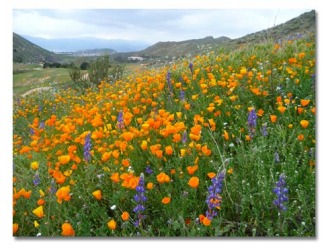Introduction
The San Joaquin Valley is a special place. It has a rich, diverse population; communities that blend rural calm with urban vibrancy; and unrivaled agricultural productivity. These qualities mean that the region will grow. In the next 40 years, the Valley will almost triple in population from 3.9 million to more than 9.5 million. The San Joaquin Valley Blueprint planning process is creating a long-range regional vision based on this population growth. Blueprints are regional in scope and integrate land use, transportation and resource planning. The planning process is based on the “Three E’s” of sustainable communities: prosperous economy, quality environment, and social equity.
Each night at select board, city council and planning commission meetings throughout the San Joaquin Valley, elected officials and appointed planning commissioners are making decisions about the future of their communities as well as the Valley. They are facing difficult decisions on a variety of issues related to such topics as housing, agriculture, economic development and the health of the environment. These board members, council members and planning commissioners care about the future of their communities and the San Joaquin Valley, but often do not have the time, resources or background to research the many options available to address the challenges they face.
Now, more than ever, planners, developers and citizens are looking for tools to help them plan for the future of their communities. Timing is critical, communities must work together to protect the quality of life of Valley residents for future generations. The eight Councils of Governments (COGs) in the San Joaquin Valley have together developed a Toolkit,which will assist Valley communities as they plan for the future through various types and stages of development.
Sustainable Growth Design Principles
Sustainable growth development is guided by a set of principles that promote strong communities with a range of opportunities for all residents. These principles ensure a spectrum of housing, employment and transportation choices in walkable, livable neighborhoods. These principles are not meant to dictate the scale or density of development. Instead, they are broad principles that can be applied throughout the San Joaquin Valley. From rural towns with their low-rise buildings and lower densities to the high-rise, high densities of their city centers. These principles can be applied to a wide variety of development projects, small scale infill development; new neighborhoods built on large infill sites; and public improvements such as streetscape projects and civic buildings.
The Sustainable Growth Principles for the San Joaquin Valley are listed below
§ Housing Opportunities
§ Walkable/Bikeable Communities
§ Community and Stakeholder Collaboration
§ Distinctive, Attractive Communities
§ Development Decisions
§ Mixed Land Uses
§ Walkable/Bikeable Communities
§ Community and Stakeholder Collaboration
§ Distinctive, Attractive Communities
§ Development Decisions
§ Mixed Land Uses
§ Preserve Open Space
§ Transportation Choices
§ Development of Existing Communities
§ Compact Building Design
§ Economic Vitality
§ Environmental Resource Management
§ Water Needs
§ Transportation Choices
§ Development of Existing Communities
§ Compact Building Design
§ Economic Vitality
§ Environmental Resource Management
§ Water Needs
Implementation ToolKit
The ToolKit is an educational guide and reference source for communities who want to translate the Sustainable Growth Principles into action. Whether you are a newcomer to land use planning, a seasoned practitioner, a community-decision maker, a state official or an active citizen interested in land use planning, this ToolKit is for you. We have designed the ToolKit to be a dynamic resource with new tools and case studies added on a regular basis. Check back often for new information! If you are looking for a particular tool that is not currently on our site, or have an example of a sustainable growth tool successfully used in your community, please contact us. We also welcome your feedback and ideas so that we can better meet your needs and ensure that the information in the Toolbox is accessible and easy to use.
How to Use this ToolKit
The ToolKit introduces users to the issues, techniques and resources for sustainable growth planning. It features case studies and sample tools that demonstrate how other communities have addressed similar challenges to those facing your community. The ToolKit is organized by Principle and contains three main sections:
§ Issues – summarizes common issues such as preserving farmland or providing housing for residents. These summaries are designed as a general overview to provide a starting point for community discussions. Additional resources are provided for those who would like to delve more deeply into an issue.
§ Tools- outlines a particular policy, plan, bylaw or technique that can be used to address a particular issue in your community. The summary of each tool describes how it can be used and where to find additional resources.
§ Case Studies– demonstrates how a community has implemented a particular tool. The ToolKit includes a range of samples from around the Country, including rural, suburban and more urban examples. Related issues, tools and case studies are also linked. For example, if your community is interested in ensuring farms remain productive (the issue), you may consider an overlay district (the tool) and look to ________ (the case study) to download their bylaws to see how one community has implemented an overlay district.
§ Issues – summarizes common issues such as preserving farmland or providing housing for residents. These summaries are designed as a general overview to provide a starting point for community discussions. Additional resources are provided for those who would like to delve more deeply into an issue.
§ Tools- outlines a particular policy, plan, bylaw or technique that can be used to address a particular issue in your community. The summary of each tool describes how it can be used and where to find additional resources.
§ Case Studies– demonstrates how a community has implemented a particular tool. The ToolKit includes a range of samples from around the Country, including rural, suburban and more urban examples. Related issues, tools and case studies are also linked. For example, if your community is interested in ensuring farms remain productive (the issue), you may consider an overlay district (the tool) and look to ________ (the case study) to download their bylaws to see how one community has implemented an overlay district.
Acknowledgements
This ToolKit was prepared by staff members from the eight Councils of Governments (COGs) in the San Joaquin Valley. We thank the following organizations who originally developed many of the tools that are contained on this website including:
§ Cumberland Region Tomorrow, Collaborative Action for Quality Growth – Quality Growth Toolkit
§ Envision Utah, A Public/Private Partnership for Quality Growth – Quality Growth Strategy, Your Community Toolbox for Quality Growth
§ San Diego Council of Government, Land Use and Regional Growth – Smart Growth Toolbox
§ Sacramento Council of Governments, Sacramento Region Blueprint, Transportation and Land Use Study – Blueprint Implementation Seminars
§ Southern California Association of Governments, Compass Blueprint, Building Partnerships, Serving Communities – Toolbox
§ Smart Growth Vermont, Forging Growth and Conservation Solutions – Community Planning Toolbox
§ Massachusetts Executive Office of Energy and Environmental Affairs – Smart Growth, Smart Energy Toolkit
§ Getting to Smart Growth, 100 Policies for Implementation and 100 More Policies for Implementation
§ National Association of Realtors – Smart Growth Toolkit
§ Envision Utah, A Public/Private Partnership for Quality Growth – Quality Growth Strategy, Your Community Toolbox for Quality Growth
§ San Diego Council of Government, Land Use and Regional Growth – Smart Growth Toolbox
§ Sacramento Council of Governments, Sacramento Region Blueprint, Transportation and Land Use Study – Blueprint Implementation Seminars
§ Southern California Association of Governments, Compass Blueprint, Building Partnerships, Serving Communities – Toolbox
§ Smart Growth Vermont, Forging Growth and Conservation Solutions – Community Planning Toolbox
§ Massachusetts Executive Office of Energy and Environmental Affairs – Smart Growth, Smart Energy Toolkit
§ Getting to Smart Growth, 100 Policies for Implementation and 100 More Policies for Implementation
§ National Association of Realtors – Smart Growth Toolkit



